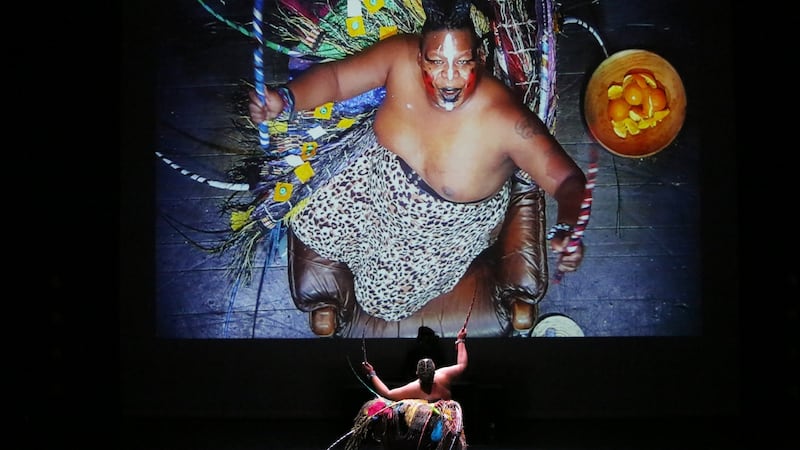Dolores ★★★★
Dolores Haze was raped and brutalised in Nabokov's novel Lolita. In Junk Ensemble's Dolores, she is dancing back at that oppression, highlighting her trauma and reclaiming her voice. Lolita is voiced by an unreliable narrator, and the audience at Dolores are also presented with competing narratives.
Split into two wristband-wearing groups, they follow either white or black batons around areas of the Chocolate Factory, encountering real and fictitious scenes based on the novel. The character Dolores is embodied by three performers (Amanda Coogan, Julie Koenig and Deirdre Griffin) while Mikel Murfi plays the dual roles of Humbert and Quilty.
Although there is no narrative thread, some episodes create first impressions that colour the perception of subsequent dances. The white-wristband group first see Dolores (Coogan) silencing Humbert by stuffing peaches into his mouth and slamming him against the wall of an attic bedroom. Revenge and inner strength become the first impression. Later, during a duet between the other two Doloreses (Koenig and Griffin), this group overhear the distant sound of the wall slamming (being performed for the black group) while watching the two dancers grapple and climb on each other’s back. There is a sense of struggle, but, in light of Dolores’s earlier resolve, the duet can also be seen as the characters tirelessly bearing each other’s weight in a gesture of self-support and self-preservation.
Denis Clohessy's music, played with aplomb by Conor Sheil and Danny Forde, attempts to leaven the proceedings, almost like Nabokov's poetic language. Its soft-spoken timbre contrasts with the scrape of skin on concrete floor or sickening conversation between Humbert and Quilty. With Valerie Reid's superb scenography, Dolores combines visual eloquence with the gut-punch of a victim impact statement.
And so you see . . . ★★★
And so you see . . . is choreographed by Robyn Orlin, but is centred on the charm and presence of performer Albert Silindokuhle Ibokwe Khoza. Seated on an armchair with his back to the audience, he faces a camera that projects his magnified image on the back wall. Closely focused, the camera reveals the smallest details on his face and body, but Khoza is unfazed by the exposure and remains completely open to the audience's gaze.
A fleeting but pointed reference to Sarah Baartman, who was forcibly displayed as the Hottentot Venus in 19th-century England, brings attention to the colonial and racist exploitation of the black body. Her commodification is in contrast with Khoza's freedom of expression throughout the dance, along with his beautiful falsetto voice and a supreme self-confidence in his body and identity. However, these days in his native South Africa, that confidence is clouded and identity is increasingly seen as fixed and binary.

(b)reaching stillness ★★★
Ion ★★★
At a superficial level, Lea Moro's (b)reaching stillness and Christos Papadopoulos's Ion are similar. Both feature male and female dancers naked from the waist up and in dark trousers; both dances play with a sense of time and spatial patterns; and both use music to format paragraphs of movement. Bathed mostly in crepuscular light, Moro's trio takes motionlessness as a starting point, in particular Baroque-era still lifes. The quiet stillness onstage gives way to tiny movements that ebb and flow, reflecting quiet resurrections and expirations as bodies change and reshape. The bombast of Mahler's Resurrection symphony periodically fades in and out and contrasts with the whimsy of wire head massagers and gold inflatable coconut trees that deflate synchronously as the dance reaches its finale. Ion is more concerned with motion, as it weaves mesmeric sequences of movement and buzzing patterns, with dancers combining, splitting and reforming into ever-changing arrangements.
Yvonne Rainer ★★★★
Yvonne Rainer returned to Dublin Dance Festival after eight years, with three works from the 1960s: Chair-Pillow, Talking Solos and Trio A. On opening night at Imma she delivered a pre-performance talk that was a mix of politics and mythology, anger and verbosity sometimes overcoming subtlety. Her dances were more eloquent, particularly the three versions of her seminal work Trio A.
In keeping with much of the Judson Church movement, this dance was a protest against and rejection of the increasing elitism of modern dance. In the midst of the Vietnam War Trio A with Flag, a version performed naked with a US flag tied around the performers' necks, was a further protest against censorship of the body and flag desecration prosecutions. Rainer was scathing of contemporary US politics in her speech and Trio A with Flag remains equally acute: 1960s flag-burning is today's taking the knee during the anthem. In spite of its background in aesthetic and political agitation, Trio A retains a lightness of being, an optimistic assertion of normality and difference through its unco-ordinated unison.
First Looks ★★★
The First Looks programme presents works-in-progress, some more complete than others. Jessie Keenan's Fragments is a slow and meditative exploration of embodied memories and how they can be recalled, while in Merlin the Iseli-Chiodi Dance Company returns to the theme of the outsider and social acceptance through a contemporary fairytale. Ruairí Ó Donnabháin's Archipelagic Thinking was a quiet polemic, expressed through the uncertainty of language more than the body. Intriguing, this presentation was rushed, a taster portion that could only serve as a hint at his concerns around migratory patterns of humans and animals, queer representation and environmental recklessness.
DAI ★★★
At the Science Gallery, Jonathan O'Hear and Martin Rautenstrauch introduced DAI, a robot with artificial intelligence that is learning dance through programming and dance videos. It can create its own performance, but since it is not self-aware, dancers' jobs are safe. For now.
Dublin Dance Festival continues until May 20th











